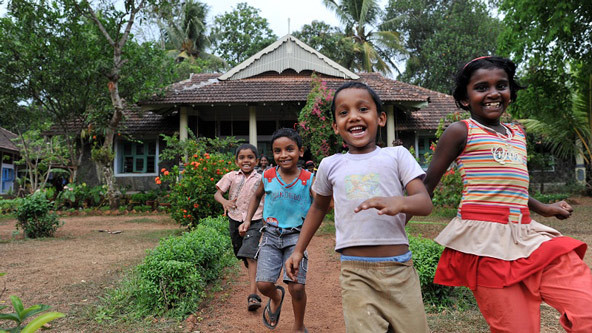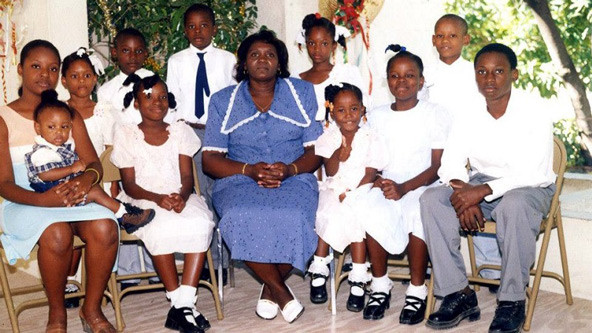 Children playing outside their home in the SOS Children’s Village of Chochin in India. With 4,526 children in 40 villages across India, SOS ensures children are raised in a loving family environment. (Photo courtesy of SOS Children’s Village)
Children playing outside their home in the SOS Children’s Village of Chochin in India. With 4,526 children in 40 villages across India, SOS ensures children are raised in a loving family environment. (Photo courtesy of SOS Children’s Village)
In Syria, in Yemen, in Myanmar, at the US-Mexico border, children are front-page news. Violence and discrimination are tearing apart families in front of our eyes. An estimated 220 million children worldwide—one in 10—live without parental care or are at risk of losing it. And lacking sufficient child welfare support, an unknown number of them will end up alone in child-led households or in institutional settings rife with neglect or abuse. They will face developmental damage, exploitation, difficulties with community reintegration, stigma, low employment, inadequate life skills, and increased social dependency.
Since the adoption of the United Nations Convention on the Rights of the Child (UNCRC) in 1989, all signatory nations have ostensibly prioritized the security and empowerment of children. Yet, as we approach the 30th anniversary of the agreement, much work remains. Progress has been uneven and uncoordinated. Gaping holes in documentation—indeed, only 45 percent of children are registered at birth—have led to chronic underinvestment in support systems. Meanwhile, the implementation of programs that do exist has often been misdirected, and in light of today’s brew of war, terrorism, and environmental crises, it may seem that even modest gains could easily erode.
To move forward, the nonprofit and donor community must first address the fragmentation of services provided to children at risk. A holistic model—one that is rooted in the family unit, and that integrates care structures, education, and job training—can provide a foundation for children that lasts a lifetime.
Connecting the Pieces
The organization I represent, SOS Children’s Villages is the largest organization dedicated to the protection of orphaned, abandoned, and other vulnerable children. It aims to ensure that every child belongs to a family, and grows up with love, respect, and security across 135 countries. Our 2016 report, “In the Blind Spot,” which analyzed international strategies and documentation focused on children without or at risk of losing parental care, found that while alternative care efforts targeted at children with inadequate or no parental care are widespread, they are often uncoordinated or too narrowly focused. In other words, an initiative targeting HIV/AIDS may have nothing to do with job creation. A program to enhance the education of girls may be unrelated to a family planning program. Educational programs providing support for students may disregard sustainable funding for schools. And so on. As a result, many children get help in one area but remain vulnerable in others.
Are you enjoying this article? Read more like this, plus SSIR's full archive of content, when you subscribe.
Our work and others’ has shown us that, to be effective in the long term, alternative care programs need to encompass all aspects of a child’s life to provide a seamless sense of security and allow them to develop skills they will need in their adult lives. In practice, the SOS approach consists of four basic pillars—prevention, long-term care, education, and advocacy.
An estimated 220 million children worldwide—one in 10—live without parental care or are at risk of losing it.
The story of Judithe, a young woman from Haiti, illustrates how this model works. Judithe’s parents died in a car crash when she was six. Haiti’s child welfare organization initially sent her to live with her uncle. Too poor to care for her, Judithe’s uncle was faced with an impossible question—how can I help this child?
Time and again, desperate relatives around the world have brought children like Judithe to an SOS Village, hoping to give them a better life. Our family-based care model, which started in Austria in 1949, provides children with loving families in a village setting. As our organization grew, we realized there was a greater need to help families become more self-sufficient with programs that prevent family breakdown.
Prevention: Working in conjunction with state welfare institutions, national SOS offices organize teams of trained social workers go into communities and liaise with parents and other community partners to identify children and families in need. SOS family-strengthening programs are designed to fill gaps in assistance from state welfare organizations, and each program is tailored to local community needs and designed for long-term sustainability—including job training and economic assistance to help caregivers achieve economic independence. This coordinated delivery of services stabilizes childhoods, increases school attendance, and improves health outcomes for households.
Our family-strengthening programs in Haiti did not start until after the death of Judithe’s parents, so her uncle was unable to benefit from them. However, the welfare agency worked with SOS to give Judith a home at the SOS Village in Santo and thus prevented her from falling between the cracks.
Long-term Care: Every child needs a supportive, protective, and caring environment that promotes their full potential. Without a long-term care model, vulnerable children are at special risk of being denied a nurturing environment. Most long-term care is designed to end at a certain age, but SOS takes a lifelong view; independence and self-sufficiency are the ultimate goal.
 Judithe (second from the left, back row) found a loving family that helped set her up for long-term success. (Photo courtesy of SOS Children’s Villages)
Judithe (second from the left, back row) found a loving family that helped set her up for long-term success. (Photo courtesy of SOS Children’s Villages)
At the SOS Village, Judithe joined a new family, gaining an SOS Mother, and 11 brothers and sisters. Mothers are professionally trained caregivers who aim to create emotionally stable and resilient relationships. They are responsible for guiding the family according to professional childcare standards, and dedicate themselves to building a secure and loving home for generations.
Education and Empowerment: Quality education and youth empowerment are important parts of outfitting children and young adults for lifelong success. Beyond academics, children must learn essential life skills—such as budgeting, cooking, and navigating workplace norms—that prepare them for independence and help them learn how to handle conflict. They also need career planning advice, job readiness training, access to vocational workshops, and mentoring.
During the years Judithe lived in the SOS Village, she received a classic academic education, learned autonomy through basic household chores, and developed collaborative soft skills through negotiating life with her 11 siblings. At 18, she graduated from high school and moved out of the village and into an SOS Youth Home while she attended college. There, Judithe lived with other SOS alumni from across Haiti in a dorm-style, semi-independent setting. She built a network of support among her peers, getting and giving advice on college courses and career options. After completing her studies, she secured an internship in a mentoring program developed in partnership between SOS and Deutsche Post DHL Group. Today, she lives in an apartment with a roommate and works for DHL full-time in the accounts receivable department.
Advocacy: Giving children and young people in alternative care the chance to participate in national and international decision-making processes can impact the provision and breadth of services, and positively affect their lives and the lives of others like them.
SOS alumni have participated in the World Conference on Youth (2014), the International Conference on Alternative Care (2016), and the UN Economic Council and Social Youth Forum (2016). Each conference convened a broad spectrum of international partners and government organizations to hear directly from youth benefitting from their programs. Participation helped the youth build confidence and community, and attendees benefitted from hearing the voices of affected children and learning about their experiences.
Lessons from Designing a Holistic Approach
Judithe’s story demonstrates that a holistic approach to care, built on a family structure, can provide the stability and continuity children at risk need to build successful lives. But it’s important to remember that even the best, most human-centered approach is pointless if it doesn’t scale to meet the need. Our years of work with the government and numerous civil support organizations in Africa’s Republic of Benin, for example, has led to new guidelines for foster care that will support more than 310,000 children in need of care services.
Children at risk need a seat at the table; they need to tell their stories and see themselves as agents of change, not victims.
In addition, alternative care initiatives are most effective when they are organized from a multi-stakeholder perspective—especially when it comes to policy development, data collection, and interventions. Our research shows that without concerted collaboration between multilateral organizations, national and local governments, NGOs, private actors, and service providers, vulnerable children will continue to languish in unsafe situations, or receive limited and misguided services.
Finally, as I mentioned above, children at risk need a seat at the table; they need to tell their stories and see themselves as agents of change, not victims. The international community of alternative care providers must be open to feedback and change as childen share their experiences with them. The message from children time and again has been to keep their right to a nurturing upbringing at the center of any national or international long-term care solution.
It is easy to become dispirited by the scope of the issues children face globally. But it is just as easy to become energized by the work of colleagues in the field. It is also instructive. In the United States, for example, many organizations are rising to the challenge in impressive and unique ways. Foster America’s fellowship program is engaging professionals with skills in data, technology, design, strategy, and finance to create more interconnected child welfare system. The nonprofit Treehouse partners with foster parents, social workers, school counselors, and others to help embed school and career planning in children’s lives over the long term—an approach that helped bring up the high-school graduation rate of students in foster care from below 40 percent to 89 percent, eclipsing that of non-fostered kids. And Hour Children is helping formerly incarcerated women and their children successfully rejoin their communities by providing supportive housing, mentoring, workplace re-entry training, daycare, and other services. One of Hour Children’s many positive outcomes is a recidivism rate of only 3.5 percent for women in the program, compared to a state average of 39 percent, and a full 100 percent of children in the program successfully completed the most recent school year. Meanwhile, 100 percent of SOS youth in the United States graduate from high school, and alumni are six times more likely to graduate from college than youth in traditional foster care. Alumni of these and other likeminded organizations are now attending college, advocating for children’s rights, and becoming powerful agents of change for themselves and the next generation.
In closing, alternative care providers and funders must ensure that our efforts to serve the long-term needs of children focus on systemic change. By providing a holistic approach to their education, security, and personal growth, and working concertedly to leverage our areas of expertise in the service of those whose survival depends on our commitment, we can set these children up for successful lives.
Support SSIR’s coverage of cross-sector solutions to global challenges.
Help us further the reach of innovative ideas. Donate today.
Read more stories by Neil Ghosh.

